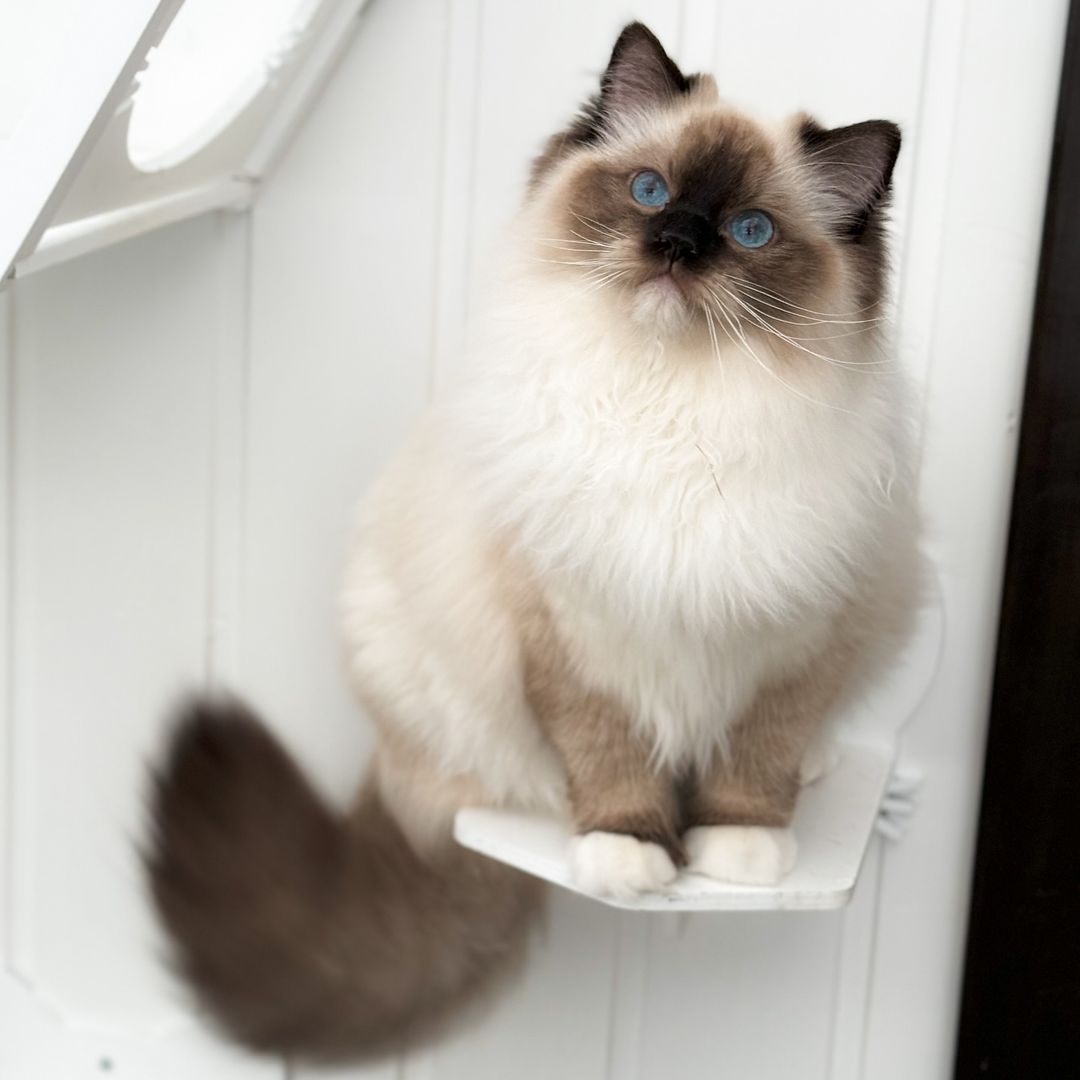PERSONALITY: Friendly, easygoing, cuddly, social
WEIGHT: Up to 20 pounds
LENGTH: Up to 40 inches
COAT LENGTH: Long hair
COAT COLOR: Chocolate, red, seal, blue, lilac, and cream
COAT PATTERNS: Colorpoint, bicolor, mitted, van
EYE COLOR: Blue
LIFESPAN: Up to 17 years
HYPOALLERGENIC: No
ORIGIN: California
Ragdoll Characteristics
The big, beautiful ragdoll cat does not reach their full size, about 15 pounds on average, until about four years of age. With their easygoing personality and social temperament, the ragdoll is ready to befriend just about anyone. Prepare your lap for extended cuddling sessions where they’ll flop like a mop across your legs and expect enthusiastic belly rubs. Ragdolls don’t need a lot of exercise or rambunctious play time, but snuggle time is essential.
They make great, loving companions for adults and respectful children. With proper introductions, they can get along with other pets in the house as well. Overall, they want to be near their families and crave their humans’ attention.
History of the Ragdoll
Ragdolls were developed in California in the 1960s by Ann Baker.1 She wanted to create a beautiful cat with a loving personality. She started by breeding a domestic long-haired, white cat of unknown origin named Josephine with other cats she either owned or found.
Though it took a few generations, Baker eventually produced the first cats she called ragdolls. These cats were appreciated for their non-matting fur, large size, and outgoing personalities.
Ragdoll Care
Ragdoll cats are fairly easy to care for, not requiring more exercise or grooming than the average cat. As always, there are certain care routines you’ll want to implement to keep your ragdoll happy and healthy.
Grooming
The ragdoll has a silky single coat (meaning there is no under-layer of fur). It’s meant to be lower-matting than other medium-haired cat coats. This breed still benefits from brushing at least twice a week to help avoid tangles. Like all other cats, ragdolls also generally need nail trims. Keep in mind that your cat will probably want to sharpen their claws even more than normal after a pedicure, so be sure to provide good scratching posts.
Shedding
Because ragdolls don’t have an undercoat, the amount of shedding and dander production is lower than that of heavier-coated breeds. However, many people are still allergic to saliva and skin secretions from cats, and ragdolls produce these allergens, so they are not considered hypoallergenic
Exercise
Ragdolls are moderately energetic, social cats. They enjoy regular playtime using wands or other interactive cat toys. Don’t just leave toys around for your kitty, though, as it’s best to get up and play together. This will help keep your cat’s weight down, avoid behavior concerns caused by boredom, and build bonds within the family. To keep them mentally stimulated, use a puzzle feeder for their daily meals.
Appearance
Purebred ragdoll kittens are born solid white due to a genetic mutation. Their coats begin to develop colors and patterns around two months of age but don’t fully develop their coloration for about two years. Ragdolls are considered a “pointed breed,” meaning their body is lighter colored than the points (face, ears, legs, and tail).
The ragdoll’s medium-length coat is silky-soft and often compared to rabbit fur. Their fur is somewhat longer and thicker around the neck, giving the appearance of a mane. Their ears are relatively small and slightly rounded. These large cats are not overly muscled; they are rather soft and quite flexible.
Diet and Nutrition
Work with your vet to develop a diet appropriate for your ragdoll’s age and activity level. Wet or canned foods help provide moisture that can help prevent urinary issues.5 Be sure to ration the food, and don’t leave it out in your cat’s bowl all day. Leaving food out could lead to overeating and obesity, a risk factor for diabetes in cats.6
Where to Adopt or Buy a Ragdoll
Take the time to get to know the breeder and the breed before making your purchase. The breeder can also help you get to know the breed and ensure that a ragdoll is right for you. You can start withThe Cat Fanciers Association to perform a breeder referral search. If you are purchasing a ragdoll from a breeder, expect to pay anywhere from $400 to $2500.
If you prefer to adopt from a rescue organization, check out local adoption venues and you may be lucky enough to find a ragdoll waiting for a new home. You might also explore Ragdoll Rescue USA/International.
Breed Overview
If you love the idea of a soft, docile, cuddly cat, then the ragdoll would make a wonderful addition to your household. Ragdolls get along with friendly people of all ages and other pets, too. They enjoy playing, but they are equally happy to just curl up and snuggle. These special cats are as beautiful as they are personable, so they are pretty much purrfect.
